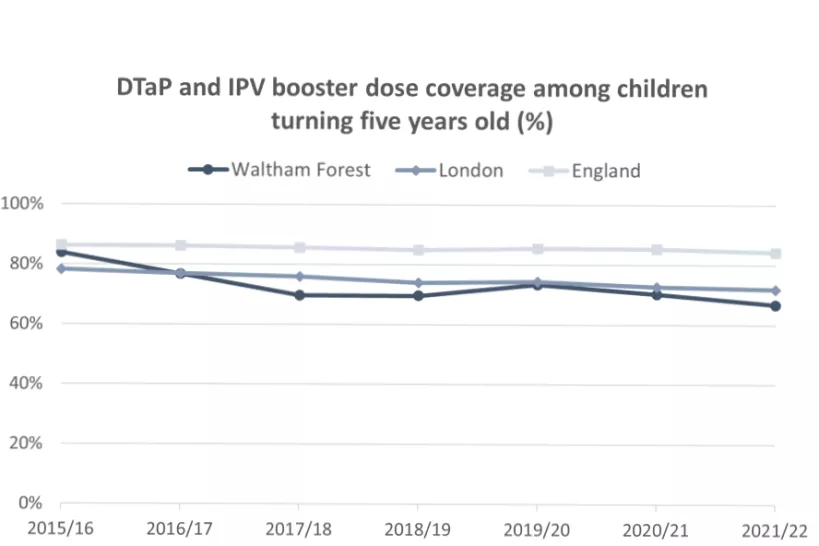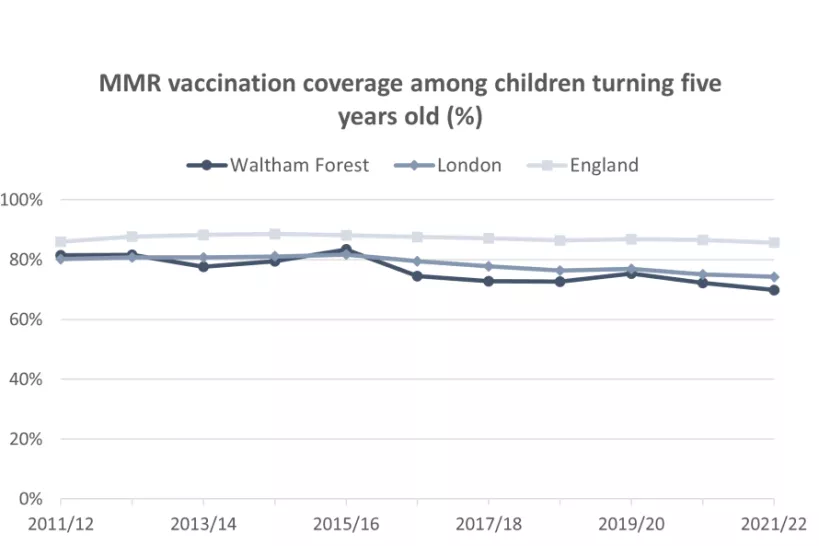Last updated: 5 April 2024
Next review: 20 June 2024
This content is part of the Waltham Forest JSNA. To see other JSNA content, visit the JSNA landing page
As a result of effective vaccination programmes the incidence of many infectious diseases have reduced significantly over time. Since vaccines were introduced in the UK, diseases like smallpox, polio and tetanus that used to kill or disable millions of people are either gone or seen very rarely. Cases of diseases like measles and diphtheria have reduced by up to 99.9% since vaccines to protect against them were introduced [1].
The World Health Organization (WHO) recommends that on a national basis at least 95% of children are immunised against a range of diseases. The routine childhood immunisation programme for the UK includes these immunisations recommended by WHO as well as others as advised by the Joint Committee on Vaccination & Immunisation (JCVI) and the UK Health Security Agency (UKHSA) [2].
According to the latest Childhood Vaccination Coverage Statistics publication, the 95% coverage target was not achieved for any of the routine childhood immunisations in England in 2021 to 2022, with coverage having declined compared to 2020 to 2021.
The uptake of childhood immunisations in Waltham Forest is significantly lower than the England and London averages. Uptake of the 4-in-1 pre-school booster vaccine uptake (protecting against diphtheria, tetanus, whooping cough and polio) and the MMR vaccine uptake (protecting against measles, mumps and rubella) are of particular concern, and are considered in more detail below.
DTaP/IPV pre-school booster vaccine
A booster vaccine for diphtheria, tetanus, pertussis (whooping cough) and polio disease is currently offered to children at the age of three years and four months old. This booster further increases the protection that children have against these diseases from having the 6-in-1 vaccine at 8, 12 and 16 weeks old.
In Waltham Forest, the proportion of children turning five years old who have received the DTaP/IPV pre-school booster has declined in the last two years compared to the pre-pandemic level. By 2021 to 2022, the coverage had declined to 66.7% compared to 73.3% 2019 to 2020 (declining by 6.6 percentage points). The corresponding decline across London and England was not as steep (2.4 and 1.2 percentage points respectively). The coverage in Waltham Forest (66.7%), as well as in London (71.8%) and England as a whole (84.2%), remains below the 95% target.

Source: OHID Public Health Outcomes Framework. Data from UK Health Security Agency (UKHSA). Date accessed: 26 April 2023.
MMR vaccine
The MMR vaccine protects against three highly infectious illnesses: measles, mumps and rubella. These conditions can lead to serious complications such as meningitis, blindness, hearing loss and problems during pregnancy. Children are offered two doses of the MMR vaccine (at 12 months and a booster at 3 years 4 months old) to ensure a high level of long-lasting protection. People who haven’t received the MMR vaccine are at significantly greater risk of contracting these illnesses and serious complications.
London has had a consistently lower uptake of MMR vaccine than the England average and any other region. In Waltham Forest, only 69.9% of children turning five years old in 2021 to 2022 had received two doses of MMR vaccine: below the London average of 74.2% and significantly lower than the England average of 85.7%.
Compared to the pre-pandemic level, the coverage for two doses of MMR vaccine at age five declined 5.5 percentage points in Waltham Forest: a bigger decline than in London or England as a whole (2.7 and 1.1 percentage points respectively).
Note that there may be some overestimation of the number of children that are due a to receive a vaccination, as a result of children who no longer live in the area remaining on local GP registers, which can lead to underestimation of coverage.

Source: OHID Public Health Outcomes Framework. Data from UK Health Security Agency (UKHSA). Date accessed: 26 April 2023.
References:
[1] NHS England (2023). Vaccinations. Date accessed: 28 April 2023.
[2] NHS Digital (2022). Childhood Vaccination Coverage Statistics – England, 2022-11. Date accessed: 28 April 2023.
[3] Public Health England (2021). Health Profile for England 2021. Date accessed: 28 April 2023.